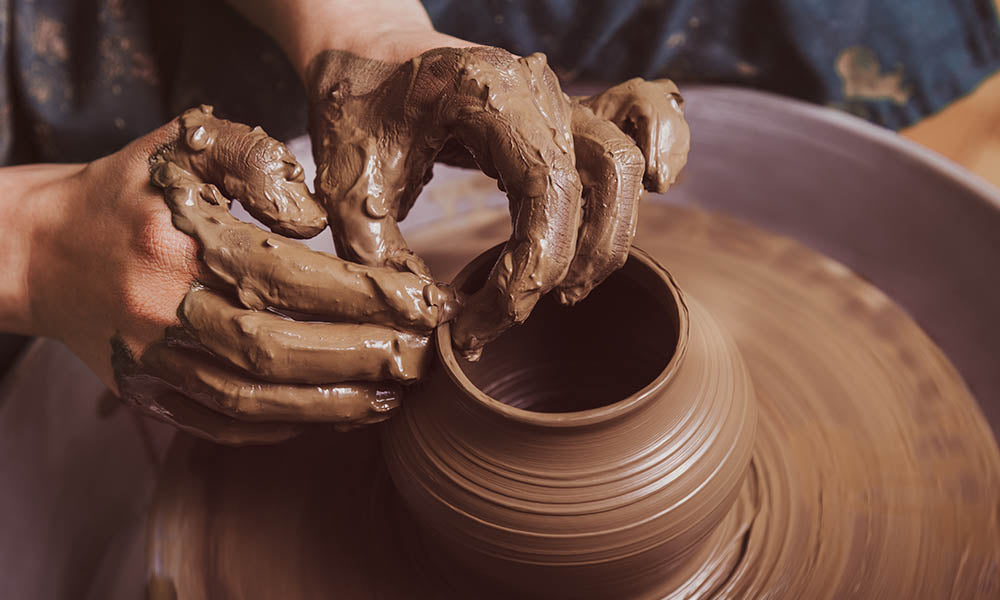
The Fascinating History of Clay: From Ancient Times to Modern Uses
Share
Clay has been an essential material for humans for thousands of years, used in everything from pottery to construction. Its natural abundance and versatility have made it a significant part of many cultures throughout history. Let’s take a journey through the fascinating history of clay and discover its importance to human development.

What is Clay?
Clay is a natural material found in the earth, composed mostly of fine mineral particles. When combined with water, clay becomes soft and moldable, making it perfect for shaping into different objects. Once it is dried and fired in a kiln (a special oven), it becomes hard and durable, which is why it has been used for many important purposes throughout history.

The Beginning of Clay Use: Prehistoric Times
The use of clay dates back to prehistoric times. The earliest examples of clay objects are believed to come from around 25,000 years ago, during the Paleolithic period. Early humans used clay to make simple figurines and tools, as well as to create fireproof cooking vessels.
Archaeologists have discovered ancient clay pots and figurines that give us insight into early human life. For instance, Venus figurines, small statues representing fertility, were made from clay in various parts of the world. These were not only artistic expressions but also served as symbols of cultural significance.
The Rise of Pottery: Ancient Civilizations
By the time of the Neolithic period (around 10,000 BC), humans had learned to mold clay into pots and vessels. These early pots were used for cooking, storage, and even burial practices. The invention of pottery marked a major advancement in human culture and technology.
Ancient civilizations like the Sumerians, Egyptians, Chinese, and Indians were pioneers in the development of clay-based technology. The Sumerians, in modern-day Iraq, were among the first to develop the potter’s wheel, allowing them to create smooth, uniform pottery that could be produced faster and in larger quantities.
In ancient Egypt, clay was used not only for pots and vessels but also for the famous clay tablets that were used for writing. These tablets were inscribed with hieroglyphics, the written language of ancient Egypt.

Clay in Ancient China and Greece
Ancient China is famous for its rich history of pottery and ceramic art. The Chinese were among the first to develop fine porcelain around 600 AD. Porcelain is a smooth, white clay that can be made into thin, translucent items, like delicate tea cups and beautiful vases. Over time, China became known for producing some of the finest ceramic pieces in the world.

In ancient Greece, clay was used to create amphoras (large storage jars) and decorative pottery. Greek potters painted their pottery with scenes of everyday life, gods, and warriors. Greek pottery, particularly red-figure and black-figure pottery, is considered some of the most beautiful in the world.

The Middle Ages and Renaissance: Clay’s Artistic Revival
During the Middle Ages, clay products took on new forms. In Europe, the production of ceramic tiles became popular for decorating buildings and churches. These tiles were often hand-painted with religious scenes or symbols.
By the time of the Renaissance, clay and pottery had become art forms, with skilled artisans creating detailed and beautiful works. In countries like Italy and Spain, the production of ceramic tiles and pottery reached new heights. Majolica, a type of tin-glazed pottery, became particularly popular during this period.
Modern Uses of Clay
Today, clay continues to be a significant material used in many industries. The creation of pottery and ceramics remains a thriving art form, with artists and craftspeople using clay to create beautiful and functional pieces.
Clay is also used in the construction industry. Bricks, tiles, and roofing materials made from fired clay have been used in buildings for centuries. In fact, many of the oldest buildings in the world are constructed using clay bricks and tiles.
Additionally, clay-based materials are used in making pottery, porcelain, and even clay sculptures. Artists continue to explore clay’s potential, and its use in art installations and decorative home goods is as popular as ever.
Giftianza’s Innovation: Printing on Clay
While traditional clay craftsmanship has been admired for centuries, Giftianza is revolutionizing the art with its cutting-edge technology for printing on clay. This innovation allows high-quality, full-color images, intricate designs, and text to be directly printed onto tiles, pots, plaques, and decorative clay products.
Unlike traditional hand-painting or glazing, Giftianza’s printed clay products offer:
-
Exceptional Precision & Detail – Capture intricate artwork, patterns, and personalized messages with stunning clarity.
-
Vibrant & Long-Lasting Colors – The printing process ensures fade-resistant and durable designs that maintain their beauty over time.
-
Customization for Any Occasion – From home décor and personalized gifts to business branding, printed clay products add a unique and modern touch.
Giftianza’s innovative process blends traditional clay artistry with modern printing technology, bringing a new era of creative possibilities to clay-based products. Whether for art, gifting, or commercial use, this breakthrough makes clay more versatile than ever before.

Conclusion: The Legacy of Clay
The story of clay is a long one, stretching back thousands of years. From the earliest hand-formed pots of prehistoric humans to the sophisticated ceramics of ancient civilizations, clay has played a key role in shaping human culture, art, and technology. Today, clay remains a vital and versatile material, used in everything from modern pottery to construction.
The next time you see a piece of pottery, a clay tile, or even a brick, remember that you are looking at a material that has been with us since the very beginning of human civilization. Clay is not just a substance—it’s part of our history and our culture, and it continues to shape the world around us.